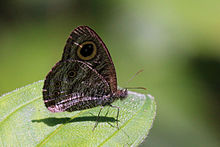Ypthima baldus
| Common five-ring | |
|---|---|

| |
| Ypthima baldus newboldi, Thailand | |
| Scientific classification | |
| Domain: | Eukaryota |
| Kingdom: | Animalia |
| Phylum: | Arthropoda |
| Class: | Insecta |
| Order: | Lepidoptera |
| Family: | Nymphalidae |
| Genus: | Ypthima |
| Species: | Y. baldus |
| Binomial name | |
| Ypthima baldus (Fabricius, 1775) | |
| Synonyms | |
| |
Ypthima baldus, the common five-ring,[1][2] is a species of Satyrinae butterfly found in Asia.[1][2]

Description
Wet-season form (in India)
Male: Upperside brown, both forewing and hindwing with terminal margins much darker, and generally with more or less distinct subbasal and discal dark bands. Forewing with a large, slightly oblique, oval, bi-pupilled, yellow-ringed black, pre-apical ocellus. Hindwing with two postdiscal, round, uni-pupilled, similar but smaller ocelli, and very often one or two minute tornal ocelli also.
Underside similar to the underside in Y. philomela but the ochraceous-white ground colour paler, tin[clarification needed]-transverse brown strice[check spelling] coarser, the ocelli on the hindwing more distinctly in echelon, two tornal, two median, and two preapical, and on both forewing and hindwing more or less distinctly defined, subbasal, discal and subterminal brown transverse bands.
Female: Differs on the upperside in having the area surrounding or bordering the ocelli on both forewing and hindwing paler, closely irrorated (sprinkled) with brown striae, the discal transverse band generally clearly defined, and very often both the tornal, and at least one of the apical, ocelli distinct. On the underside it is paler than the male, and has the subbasal, discal and subterminal transverse dark bands more clearly defined.[3][4]
Dry-season form (in India)
Males and females: Upperside very similar to the above, paler; in the female often the ground colour ochraceous white, closely irrorated with brown striae; ocelli as in the wet-season form, but those on the hindwing often non-pupilled. Underside also paler than in the wet-season form, the subbasal, discal and subterminal bands on the whole more prominent; ocelli on the hindwing reduced to mere specks.[3][4]
Wingspan of 38–46 mm.
- Mating pair and other specimens in Japan
- Underside, wet-season form
- Underside, dry-season form
- Upperside, wet-season form
- Upperside, dry-season form
Distribution
Bangladesh, Bhutan, China (mainland and Hong Kong), India (sub-Himalayan areas from Chamba to Sikkim; central India and the hills of southern India and the Western Ghats, Assam),[3] Indonesia (Borneo), Japan, Korean Peninsula, Malay Peninsula, Cambodia, Myanmar, Pakistan, Russia (Kuril Islands), Singapore, Taiwan, Thailand and Vietnam (north part).
Subspecies

Sabah, Borneo, Malaysia
The species may be divided into the following subspecies:
- Ypthima baldus baldus (India to Indochina, Burma, Thailand, Cambodia and southern Yunnan)
- Ypthima baldus hyampeia Fruhstorfer, 1911 (southern Ussuri and Korea)
- Ypthima baldus jezoensis Matsumura, 1919 (Kuriles)
- Ypthima baldus luoi Huang, 1999 (Yunnan)
- Ypthima baldus marshalli Butler, 1882
- Ypthima baldus moerus Fruhstorfer, 1911
- Ypthima baldus newboldi Distant, 1882 (Peninsular Malaya, Langkawi, and Singapore)
- Ypthima baldus okurai Okano, 1962 (Taiwan)
- Ypthima baldus pasitelides Fruhstorfer, 1911 (Bawean)
- Ypthima baldus selinuntius Fruhstorfer, 1911 (Borneo and Natuna Islands)
- Ypthima baldus zodina Fruhstorfer, 1911 (Taiwan)
See also
- List of butterflies of Bangladesh
- List of butterflies of China (Nymphalidae)
- List of butterflies of India
- List of butterflies of Japan
- List of butterflies of the Korean Peninsula
- List of butterflies of Pakistan
- List of butterflies of Peninsular Malaysia
- List of butterflies of Singapore
- List of butterflies of Taiwan
References
- ^ a b R.K., Varshney; Smetacek, Peter (2015). A Synoptic Catalogue of the Butterflies of India. New Delhi: Butterfly Research Centre, Bhimtal & Indinov Publishing, New Delhi. pp. 180–181. doi:10.13140/RG.2.1.3966.2164. ISBN 978-81-929826-4-9.
- ^ a b Savela, Markku. "Ypthima Hübner, 1818 Rings Ringlets". Lepidoptera - Butterflies and Moths. Retrieved 2018-03-18.
- ^ a b c
 One or more of the preceding sentences incorporates text from this source, which is in the public domain: Bingham, Charles Thomas (1905). Fauna of British India. Butterflies Vol. 1. p. 134.
One or more of the preceding sentences incorporates text from this source, which is in the public domain: Bingham, Charles Thomas (1905). Fauna of British India. Butterflies Vol. 1. p. 134.
- ^ a b Moore, Frederic (1893). Lepidoptera Indica. Vol. II. London: Lovell Reeve and Co. pp. 58–63.




